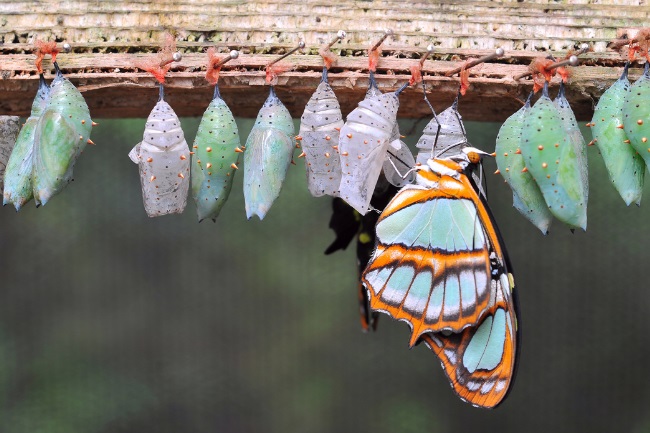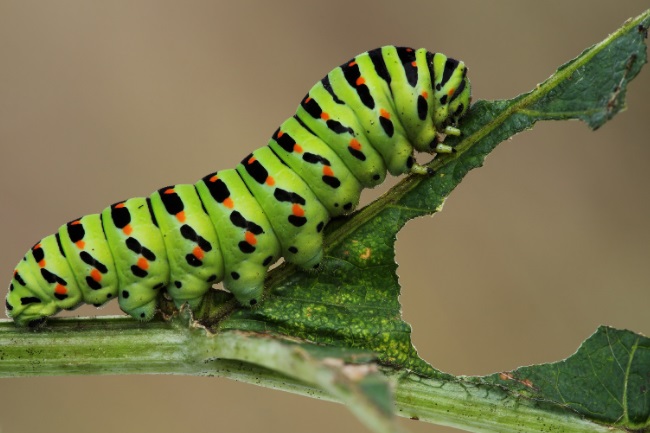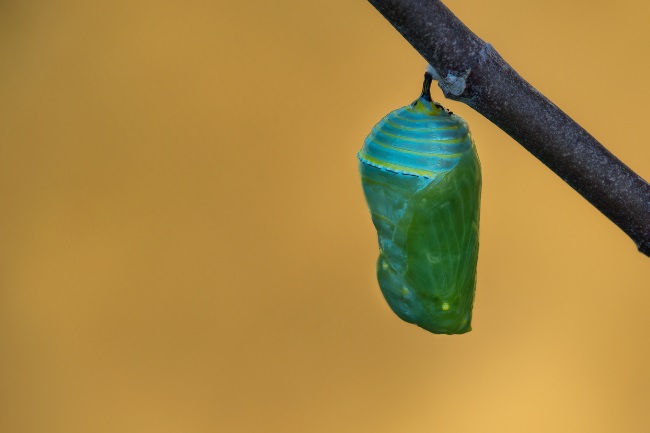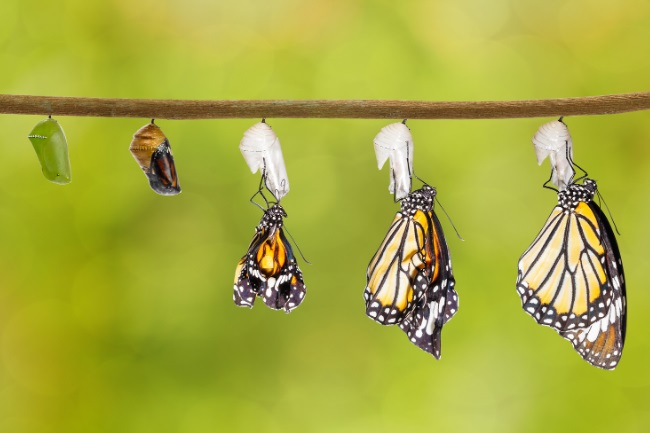Caterpillars turn into butterflies or moths through a process called metamorphosis. Hatching from an egg, they feed and grow, till they turn into a pupa or chrysalis. Once ready they will emerge again, as an adult.
Contents
How does a caterpillar become a butterfly?

Caterpillars are the larval stage of Lepidoptera species, meaning butterflies and moths. Many insects go through a similar lifecycle, starting as an egg, which hatches into larvae, then enters a pupal form and finally emerges as an adult. This cycle has perhaps been made most famous by butterfly species, which are held up as examples of these four stages, but beetles, flies and other insect species also go through it.
| Stage | Key Changes |
|---|---|
| Egg to Caterpillar | Egg hatches, caterpillar emerges and starts feeding |
| Caterpillar to Pupa | Caterpillar forms a chrysalis, internal changes occur |
| Pupa to Butterfly | Transformation into adult butterfly, wing development |
Also read: Is a Caterpillar an Insect? (Explained)
From egg to caterpillar
The life of a moth or butterfly starts as an egg. What this egg looks like, how big it is, and whether it’s snuggled up beside siblings or out on its own is highly variable depending on the species. Seen without any additional aid, these eggs can look small and uninteresting, little blobs of white or yellow on a leaf’s underside. Yet under a magnifying glass, they are stunning structures, looking like tiny sculptures. The egg of the purple hairstreak butterfly looks like a small white sea urchin, while that of the orange-tip butterfly resembles a tiny orange cocoa pod.
The small white butterfly will gently lay a single egg before moving on to find a suitable home for another. By comparison, the peacock butterfly is liberal with its egg-laying, placing around 400 in a single location. The rate of hatching also varies. Most eggs hatch within a few days, though some may take two-three weeks. Some species, such as the banded hairstreak, overwinter as an egg, meaning they do not hatch for several months; however, this is relatively unusual.

Whether our caterpillar finds itself alone or with its siblings, the first move is generally to eat its eggshell; this provides it with a boost of energy before it goes on its way to locate more grown-up food. All caterpillars start fairly small and must eat their way to a proper weight. What they eat varies, though most are plant eaters. Those who eat plant matter will either be generalists or specialists, happy to munch away on many plant species or wanting to stick to one particular plant.
In general, its mother will have laid the egg on a suitable plant. However that’s about all the maternal care these tiny insects will receive. Once they’ve eaten what they’re living on, they will have to find their way to a new snack. Some may even eat their siblings if resources get low enough. For carnivorous species, they will have to get hunting, using their predatory instincts to get their first meal.
The appearance of a caterpillar often changes a great deal during its life. They will moult their exoskeletons several times to grow in size, and with this potentially change their form and colourings. Many have excellent camouflage to help them to avoid being eaten.
The comma caterpillar resembles bird droppings to put off hungry mouths, whilst many looper caterpillars make an excellent impression of a stick. Some go the other way and make themselves look terrifying. The elephant hawkmoth caterpillar has two large eyespots behind its head. When it feels threatened, it will puff up this area to make itself look somewhat like a tiny snake.
Many caterpillars don’t have to pretend to be threatening, though, having nasty stings or toxic poisons which would make handling or eaten them a mistake. Puss moth caterpillars in the US are said to have such a terrible poison in their stings that they will make your bones hurt. While the cinnabar moth caterpillar warns of its concentrated toxins through bright and contrasting colours. Many caterpillars will also use spines as a defence, either to break off and irritate their assailant’s skin or to inject them with poison.
Also read: What Eats Caterpillars? (A List of its Enemies)
From caterpillar to pupa
The life of a caterpillar is focused on growing and eating. The amount they eat will affect their chances as an adult, and therefore the likelihood they will have offspring. Most caterpillars go from egg to pupa in 1-3 weeks. However some, like the grizzled skipper, take two months.
Those that overwinter as caterpillars can stay in this form even longer, and the most extreme example has to be the banded woolly bear caterpillar. This caterpillar lives for up to fourteen years in its larval form. It has adapted to freeze solid during the winter, without damaging its body, unfreezing in the spring and continuing to eat.

Once the caterpillar has eaten its fill, it’s time to enter its pupal stage. The pupa is a largely stationary stage in which the caterpillar completely alters its anatomy. In butterflies, the pupa is commonly called a chrysalis, though both words can be used. To become a pupa, the caterpillar must rid itself of its old skin, moulting a final time.
The way different species go about the pupal stage varies quite significantly. For all caterpillars, it requires their old skin to be shrugged off and a new form to appear. The pupa is essentially a living bag, inside which the caterpillar’s cells have been broken down to a kind of soup. The outside is often relatively featureless, though the outline of some limbs and bodyparts can sometimes be made out.
Many butterfly species they will attach themselves to a plant with silk and then hang upside down, wriggling themselves out of their outer layer of skin. Others will face upwards instead and wrap a small line of silk around their bodies to keep them from toppling over once their limbs are no longer able to hold them.
Many moth species will add an extra layer of silk around their pupa, known as a cocoon. The most famous cocoon maker is the silkworm, which spins a dense layer of silk around its body. This silk has long been harvested by humans for use in the production of expensive fabrics. Cocoons can provide an additional layer of protection from the elements, or parasites.

Although we tend to think of pupa hanging from plants and other vegetation, many species pupate on the ground or in the soil. As many of these pupae are brown, they become very hard to spot amongst winter leaves or dirt. Some butterflies have a clever way to make sure they are taken extra care of during these vulnerable months. The chalk hill blue caterpillar feeds on plant species, but when it becomes a pupa, it releases scents that encourage ants to collect it and bury it somewhere safe.
Many chrysalis are well camouflaged, their forms resembling dead leaves or thorns. Some moth caterpillars cover their cocoons in bits of dirt or vegetation to keep it hidden, while others rely on tucking it away out of sight. For all species, this is a risky time.
Even if the pupa isn’t eaten or damaged in the winter, it may fall somewhere inappropriate, and the delicate wings could be deformed when they emerge. Some pupae can move or make sounds if disturbed, to scare away predators. The pupa of the green hairstreak makes a squeak so loud it is audible to human ears.
Also read: Does a Caterpillar Need Water? (Desiccation Explained)
How long does a caterpillar stay in a cocoon?

Cocoons are only used as long as the pupa is within them and will be broken out of once the adult emerges. Some moths and butterflies will just be in their pupa less than a week, whereas others will overwinter in this form and therefore be in it for many months. The process of exiting the pupa is long and treacherous.
The young moth or butterfly is very delicate, and even a leaf brushing against them could damage them so they cannot fly. After pulling themselves out of the shell of the pupa, they will sit still to allow their wings, and the rest of their bodies, to expand and harden. During this time, if they are found by a predator, there’s very little they can do other than try to run away.
The chrysalis, pupal skin or cocoon is abandoned, of no use to the adult that has emerged from it. Now their main job is to feed and mate, and hopefully avoid being eaten. Some empty pupa or cocoons an be utilised by other species as a shelter, such as by spider and ants.
Also read: Can a Butterfly’s Wings Grow Back? (Explained)
How long does it take a caterpillar to turn into a butterfly?
All stages of butterfly’s or moth’s life are highly variable. Largely this depends on the species, but there can also be some variability because of conditions and food availability. Some species can complete their whole lifecycle in a few months, whereas for others, it can take years.
Within species, there will even be significant variations between different broods, with summer broods often living quicker and shorter lives. In contrast, winter broods will have several months where they are completely inactive, and therefore a longer overall lifespan.
Do all caterpillars turn into butterflies?
Although many species have caterpillar-like larval stages, most are called by other names, such as grubs, larvae or maggots. Sometimes sawfly larvae are called caterpillars simply because they so resemble the caterpillars of moths and butterflies. If in doubt the number of legs is a key identification feature.
The larvae of beetles doesn’t have the prolegs of the caterpillar, only have three sets of true legs. The sawfly larvae, which is often the easiest to confuse, has three true legs, but then more than five prolegs, while lepidoptera species only have a maximum of five, aside for a few notable exceptions.

In general, therefore, when referring to caterpillars we are talking about the juvenile stage of moth and butterfly species. Often we think of butterflies as being more attractive of the two, and therefore might think all striking caterpillars must be butterflies. However, there are many beautiful and fascinating moth caterpillars, such as the amazing sycamore moth caterpillar, which is covered in orange and yellow spikey hairs.
Identifying caterpillars can be tricky though, with plenty of pale green or brown species, without many distinguishing features. Something that can help with this is looking at what the caterpillar is eating, as many have very specific foodplants.
Also read: What Caterpillars Turn Into Butterflies? (Species Explained)
The magic of metamorphosis
There is certainly something magical about the journey from a caterpillar to a butterfly or moth. It’s a process we teach our children and use for a metaphor for our lives. While we tend to simplify this journey it is actually very different for different species. However, if anything this only makes it more fascinating.

